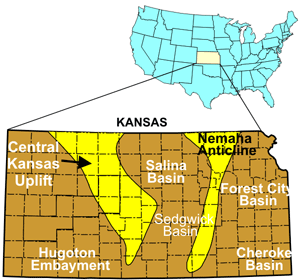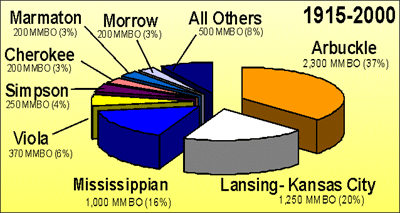Upper Pennsylvanian Lansing-Kansas City Group
Geology and Architecture
Lansing-Kansas City oolitic reservoirs exhibit geometries and architectures similar to modern oolites. Reservoirs usually contain multiple stacked, or en echelon shoals that formed in response to sea level fluctuations. It appears that two such lobes are stacked in the Plattsburg Limestone at the planned CO2 miscible flood site represented by the core. Oomoldic reservoirs formed across the entire Kansas Pennsylvanian ramp, however, thicker, porous and permeable oolite deposits are commonly associated with the flanks or crests of paleostructural highs. These highs, such as that underlying the Hall-Gurney Field, may have influenced the intensity of early diagenesis and may have been responsible for development of good reservoir properties. Grain size variation, location on oolite buildups and interbedded carbonate mud (aquitards) influenced the nature and extent of diagenetic overprinting.
Subaerial exposure and meteoric water percolation led to cementation around the aragonite ooids and often dissolution of the ooids and variable development of matrix and vuggy porosity. Resulting oomoldic grainstones, the principal reservoir lithofacies, underwent variable degrees of early or later fracturing and crushing, providing connection between otherwise isolated oomolds.
Petrophysics and Reservoir Properties
Porosities in these oomoldic limestones range up to 35% and
permeabilities range from 0.001-400 md. Permeability is principally controlled
by porosity, oomold connectivity, and connection created by matrix crushing
and fracturing. Permeability is also influenced by oomold diameter, oomold
packing, and matrix properties. Increasing bioclastic constituents within
and bounding oolite beds are often associated with increasing mud matrix
and decreasing porosity and permeability. Individual wells exhibit porosity-permeability
trends with less variance than the overall trend exhibited by L-KC oomoldic
limestones.
Within the L-KC 'C' zone in the Hall-Gurney field and the CO2 demonstration
site, permeability decreases from the top of the bottom of the LKC 'C' interval.
Lower permeability with increasing depth in the reservoir interval is attributed
to increased dense bioclastic limestone content and decreasing moldic porosity.
Correlations of “irreducible” water saturations (measured at pressures equivalent to 60-120 feet above free water level) indicate that Swi increases with decreasing permeability following the trend:
logSw50 (%) = 0.22 log k(md)) - 0.43
Lansing-Kansas City oomoldic limestones exhibit a near log-linear trend between wetting phase saturation and oil-brine height above free water level with capillary pressures decreasing with increasing permeability at any given saturation and can be modeled using the relation: Pc = 10(A Sw + B) (rwater-roil).
Residual oil saturation to waterflood (Sorw) is a critical variable for both waterflooding and carbon dioxide miscible flooding since this represents the target resource. Most L-KC waterfloods in Kansas have only involved 1-5 pore volumes (PV) throughput before reaching their economic limit. At 5 pore volumes throughput Sorw averages near 30%. Though sampling is limited, Sorw may increase then decrease with increasing permeability (k).
Importance of Moldic Reservoirs to Kansas Oil and Gas Production
 Kansas
reservoirs have produced nearly 6.3 billion barrels of oil (BBO) to date,
with a significant majority of the past production coming from reservoirs
in proximity to the Central Kansas Uplift (CKU). Of the 6.3 BBO, 73% (4.5
BBO) has been produced from Arbuckle Gp, Mississippian, and Lansing-Kansas
City Gp reservoirs that are predominantly moldic porosity systems.
Kansas
reservoirs have produced nearly 6.3 billion barrels of oil (BBO) to date,
with a significant majority of the past production coming from reservoirs
in proximity to the Central Kansas Uplift (CKU). Of the 6.3 BBO, 73% (4.5
BBO) has been produced from Arbuckle Gp, Mississippian, and Lansing-Kansas
City Gp reservoirs that are predominantly moldic porosity systems.

Arbuckle Gp reservoirs account for 37% of all production (2.4 BBO) but are declining in production and presently represent 20% of annual production. With declining Arbuckle Group production, Mississippian reservoirs account for 33% of the total state production over the last decade and are increasing in importance. Lansing-Kansas City reservoirs represent 16% of current production.
|
|
e-mail : webadmin@kgs.ku.edu
Last updated May 2003
http://www.kgs.ku.edu/PRS/publication/2003/ofr2003-32/P1-03.html
